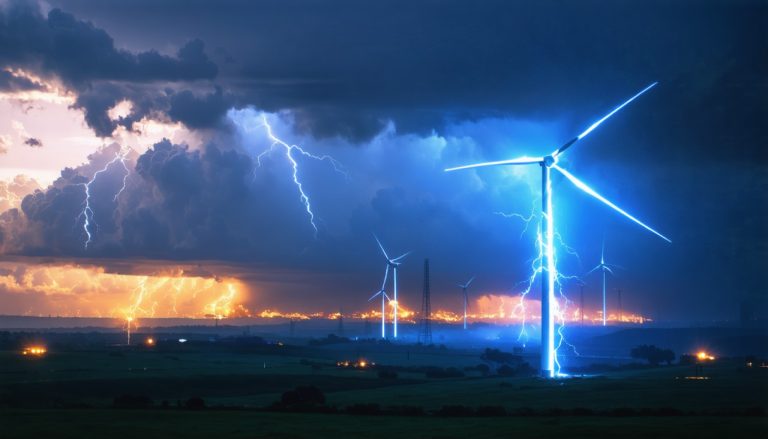
- Oklahoma State University’s Hamm Institute hosted a summit uniting tech pioneers, energy leaders, and academics to tackle AI’s energy demands.
- The growth of AI, driven by big data and machine learning, necessitates a robust energy grid.
- The summit emphasized the need for the U.S. to strengthen its energy infrastructure to maintain AI leadership.
- Dr. Ann Bluntzer Pullin highlighted the need for harmonized strategies combining innovation with infrastructure development.
- Key leaders, including U.S. government officials, stressed the importance of modernizing infrastructure to support future technological innovations.
- The event called for collaboration among technology, energy, and academia to create sustainable solutions.
- The summit underscored the critical role of energy scalability in America’s future AI advancements and technological dominance.
The winds of change blew through Oklahoma State University’s Hamm Institute for American Energy as a tapestry of tech pioneers, energy moguls, and academic visionaries convened to address a pivotal challenge of our age: How does one power the meteoric rise of artificial intelligence with energy that is as reliable as it is expansive? In an age where whispers of AI’s transformative power echo in every industry, this global leadership summit was a clarion call for change and collaboration.
Amidst the high-powered congregation, the urgency was palpable. The AI tapestry is woven with threads of big data, machine learning, and deep neural networks, all demanding an energy grid robust enough to sustain their expansive growth. As AI gallops ahead, powered by breakthroughs and innovations, participants at the summit grappled with a stark reality: the United States must fortify its energy infrastructure to maintain its leadership in the AI arena.
Under the auspices of the Hamm Institute, this unprecedented summit marked the first union of technology, energy, and academia, creating a crucible for developing strategies essential in this new era. Dr. Ann Bluntzer Pullin, the guiding force behind the Hamm Institute, articulated the summit’s essence. She envisioned a harmonized strategy where innovation and infrastructure development proceed hand in hand, ensuring that America doesn’t just keep pace with AI advancements but leads them.
Leaders like U.S. Secretary of the Interior Doug Burgum and Secretary of Energy Chris Wright took center stage, emphasizing a unified governmental effort. These leaders painted a bold roadmap for the future, highlighting the importance of modernizing the infrastructure and unveiling a future where America’s energy capabilities could spur the next epoch of technological innovation. It became abundantly clear: to lead in AI is to master energy scalability.
The summit wasn’t merely a meeting of minds but a cradle for bold strategies and dynamic leadership. With figures like U.S. Secretary of Agriculture Brooke Rollins and EPA Administrator Lee Zeldin actively contributing to the dialogue, the breadth of governmental involvement underscored the multifaceted nature of the challenge. They outlined strategies to bolster rural power systems, echoing the summit’s motif of collaboration and innovation.
The echoes of the summit are set to resonate well beyond the halls of the Hamm Institute. As AI’s capabilities continue to expand, the American energy renaissance also promises to expand, driving not only technological advancement but also ensuring a sustainable future. The summit echoed a vital message: America’s dominance in the AI age will be fueled by its capacity to innovate in energy as much as in technology. The path forward may be steep, but with hands united, the summit declared a collective readiness to ascend.
How AI and Energy Convergence Can Shape the Future: Insights from the Hamm Institute Summit
The Fusion of AI and Energy: Building a Resilient Future
The recent summit at Oklahoma State University’s Hamm Institute for American Energy transcended a mere gathering of industry experts; it served as a vital forum dedicated to tackling the pressing dilemma of powering artificial intelligence’s (AI) monumental growth with sustainable and reliable energy. Stakeholders from diverse sectors congregated to deliberate how America can remain a leader in both AI and energy innovation.
What Are the Challenges of Powering AI?
AI progresses largely due to its capacity to handle large-scale computations and data processing through machine learning and deep neural networks. This tremendous processing demand places an enormous burden on our current energy grids. Traditional grid systems, often outdated and inefficient, struggle to provide the necessary power in a sustainable manner. Hence, revitalizing infrastructure is more crucial than ever.
Key Highlights from the Summit
1. Integration of Technology and Energy
Dr. Ann Bluntzer Pullin emphasized the need for a synergetic approach where energy infrastructure development is in tandem with AI advancements. True success lies in harmonizing both sectors to ensure that technological progress is not hindered by energy constraints.
2. Governmental Role and Collaborative Efforts
U.S. leaders like Doug Burgum and Chris Wright underscored government initiatives to refresh and modernize national infrastructure. Their advocacy for rural power systems aligns with boosting local community involvement and innovation, ensuring more distributed and resilient energy networks.
3. Multisectoral Involvement
The summit featured contributions from influential figures, such as U.S. Secretary of Agriculture Brooke Rollins and EPA Administrator Lee Zeldin, emphasizing how the intersection of agriculture, environmental protection, and energy can provide holistic solutions to these pressing challenges.
Real-World Use Cases: AI and Energy Solutions
– Smart Grid Technology: Smart grids can optimize energy use by delegating resources efficiently and reducing energy waste. By employing AI, smart grids can predict demand spikes and adjust accordingly, leading to a more stable output.
– AI-Enhanced Renewable Stations: AI algorithms improve the operation of renewable energy sources like solar and wind by predicting weather patterns and optimizing energy collection and storage.
Predictions: What Lies Ahead for AI and Energy
According to a MarketWatch report, the AI energy market is projected to grow significantly, driven by the increasing demand for sustainable solutions. As AI becomes more pervasive, leveraging renewable energy becomes a competitive necessity. The collaboration between sectors signals a transformative period where innovation in both technology and energy are intertwined.
Recommendations for Immediate Implementation
– Invest in Smart Grid Infrastructure: Local governments and companies should invest in modernizing their infrastructure with smart technology that incorporates AI to forecast energy needs dynamically.
– Push for Policy Innovation: Advocate for governmental policies focused on research and development subsidies that target sustainable energy technologies integrated with AI.
– Encourage Cross-sector Partnerships: The confluence of AI and energy requires robust collaboration. Establish partnerships between tech companies, energy providers, and governmental bodies to innovate sustainable energy solutions.
Quick Tips
– For businesses: Explore energy-efficient AI models to reduce carbon footprints without compromising performance.
– For policymakers: Promote public-private partnerships focused on innovating clean-energy technologies.
– For households: Employ smart home technology that utilizes AI for energy conservation.
For further reading, consider visiting Oklahoma State University.
This summit signifies a crucial moment for setting a sustainable path for the future, requiring persistent efforts and commitment from all stakeholders. As AI continues to shape industries, a resilient and innovative energy infrastructure is imperative for maintaining leadership and ensuring sustainable growth.



